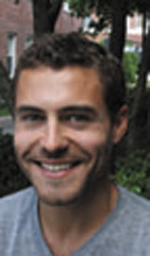Studying traffic circles runs in the family of Nathan Belz, who grew up in Readfield.
Belz, 28, is a doctorate candidate at the University of Vermont. A cousin, Darryl Belz, is a traffic engineer with the state Department of Transportation and helped design the traffic circles that will be used to make Interstate 95’s Exit 113 function in all directions.
Nathan Belz recently shared a national transportation award with Brian H. Y. Lee, an assistant professor in the School of Engineering, for a recent study involving ride-sharing in Vermont. The Fred Burggraf Award from the Transportation Research Board recognizes work by researchers under age 35.
There’s a cash award, plus paid transportation for their attendance at a January 2013 transportation conference in Washington, D.C., Belz said.
However, traffic circles are the topic of Belz’ doctoral studies.
He recently talked about them while on a sailboat in a bay in Colchester, Vt.
“It didn’t really occur to me to study roundabouts (traffic circles) until I studied for my master’s degree with Per Gårder at the University of Maine,” Belz said. Belz earned both his undergraduate and master’s degrees in civil engineering at UMaine.
He’s an unabashed fan of traffic circles, which are seen in northern New England as well as Canada.
“They’re much more efficient,” he said. “They’re easier. If you come to one in the middle of the night, you don’t have to wait for lights to change.”
He also noted that people’s opinions about traffic circles vary as well as their ideas on how to drive on them.
“They’re either pro or con,” he said, with not much middle ground.
His dissertation is in three several parts. “The first is about opposition to roundabouts in Maine, New Hampshire and Vermont and where they were built and where they were proposed but not built and why,” he said.
“The latter two sections are modeling roundabouts and modeling them better than we are currently and taking into account behaviors that are pretty understudied.”
Those behaviors include how people access traffic circles. “Usually you wait for a gap between two cars, but there are others who force their way in,” Belz said.
Some of Belz’s research is at www.uvm.edu. He expects to receive his doctorate next spring and hopes to go on to a professorship or to post-doctoral studies.
He frequently returns to Readfield, which is still his permanent residence.
Belz is featured in an article by Dawn Densmore, director of outreach and public relations, for UVM’s college of engineering and mathematical sciences.
Densmore also talked to Lisa Aultman-Hall, professor at the UVM Transportation Research Center and Belz’s academic adviser.
“Receiving this award is very significant because this is a cross TRC competition with one to two winners per year,” Aultman-Hall told her.
“Belz and Lee competed with researchers in all areas of transportation from planning to structural engineering to modeling to rail.”
Send questions/comments to the editors.



